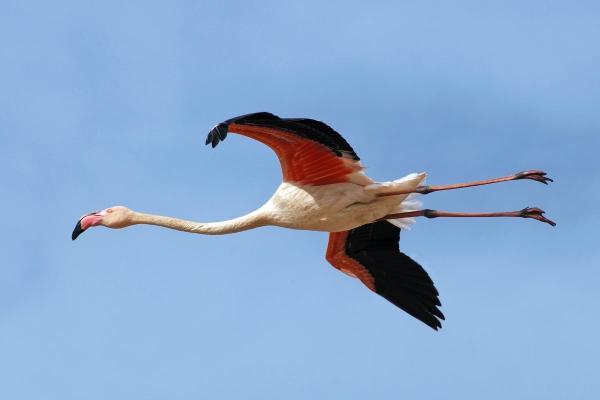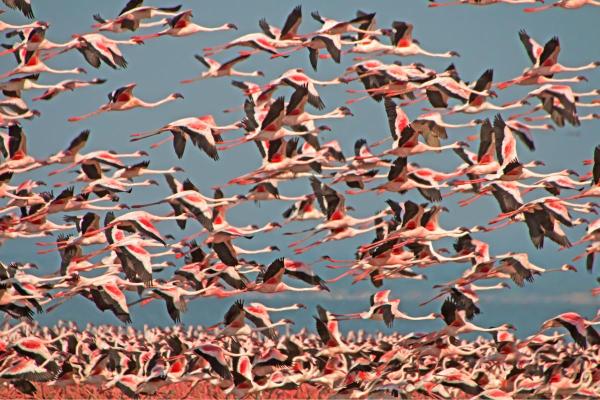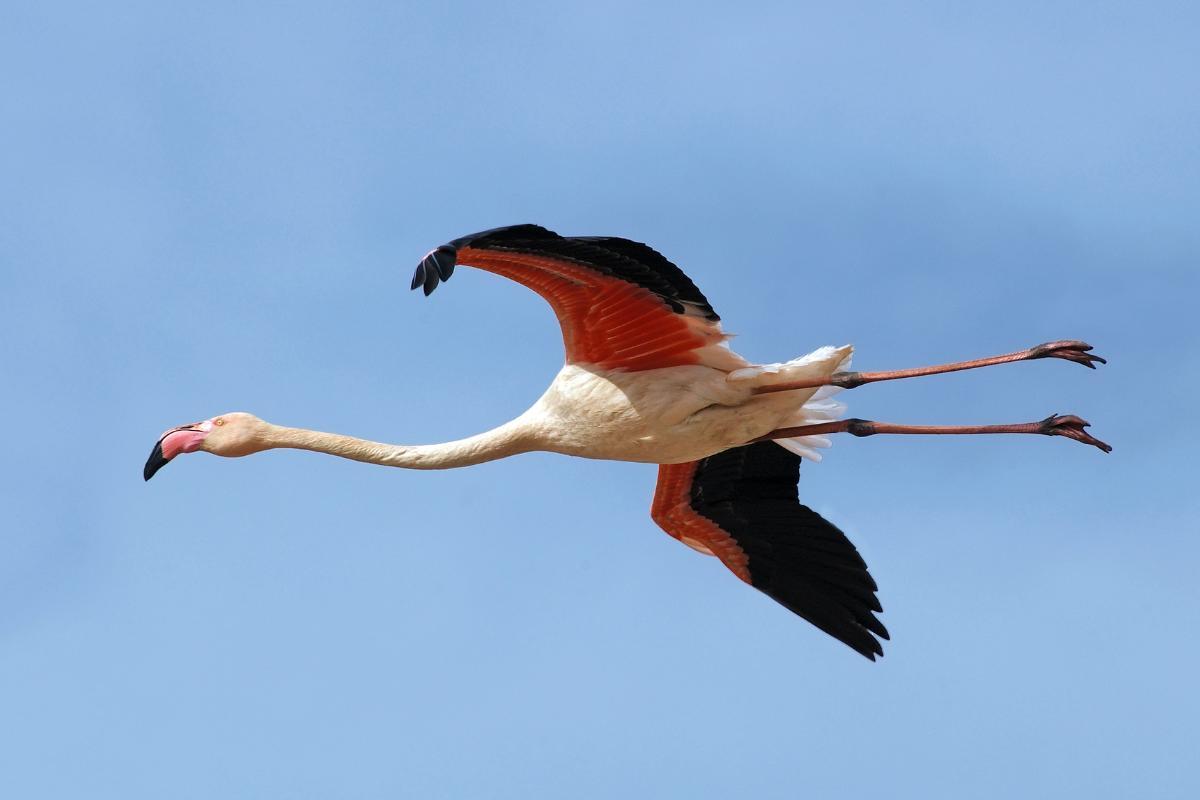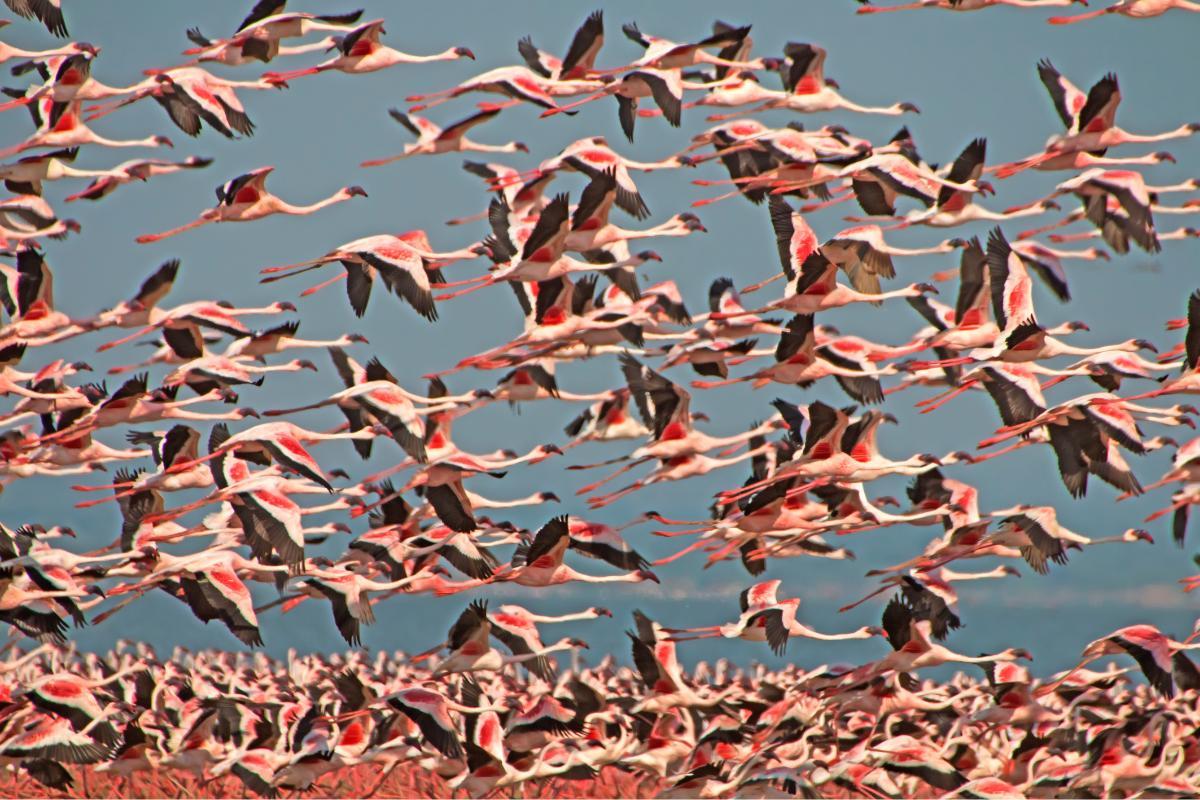Do Flamingos Fly?


Yes, flamingos do fly. We may most associated them with standing in one place and doing so on one leg, but these birds have the ability of flight. Not only can flamingos fly, they are excellent fliers. As migratory birds, flamingos need to fly very long distances in search of food and a suitable place to reproduce. They would not be able to fly such long distances without a specialized anatomy which allowed them to remain in the air for very long periods. Some birds are only able to fly short distances or for short periods of time. Flamingos are not only able to fly, they are incredible at it. Learn more about the flight of flamingos as thedailyECO asks do flamingos fly?
Do flamingos fly or not?
Yes, flamingos do indeed fly. Many people ask this question because they are perhaps most used to seeing flamingos standing in shallow water for extended periods of time. As wading birds, flamingos live along coastal lagoons, wetlands and other aquatic areas. They spend much of their time filtering the water for algae, diatoms and invertebrates to consume as food.
All this goes to say that there are long periods of time when flamingos do not fly. In this way, they fly out of necessity. In the short term, this could be due to finding food or escaping a predator. Over the long term, the reason is for migration. As a type of migratory bird, they need to fly long distances without stopping. To do so, they can fly for many hours and cover hundreds of miles before they need a rest.
Young flamingos begin to fly between 2 and 3 months of age. It is common for flamingos in captivity to have their flight feathers clipped to prevent them from flying. This may be one reason why some of them wonder if flamingos are flightless birds. Many captive flamingos have such restrictions that limit their ability to fly, something which definitely affects their health and well-being.
Flamingos are capable of reaching speeds of up to 37 mph (60 kph) in the air, especially when there is a favorable wind. They often fly more slowly on shorter flights. Like many migratory birds, flamingos prefer to take advantage of air currents to glide. This allows them to conserve energy during their long journeys. This efficient flight style allows them to move gracefully and agilely through the air.
It's important to mention that all types of flamingo species can fly, although their flight frequency varies depending on their environment. When searching for food and migrating, these social birds often fly in groups and create a stunning visual spectacle in the process. Flying together over calm waters enhances their beauty, as their vibrant colors reflect off the surface. This scene is not only stunning, but also highlights the unique nature of flamingos as migratory birds.
When do flamingos fly?
Flamingos limit their flight to periods when it is necessary. Generally speaking, they tend to wade in search of food. There are situations that require them to take flight, primarily to escape predators, return to safer waters or discover new feeding grounds. It is true to say that flamingos spend more of their time on the ground than in the air.
One of the most common reasons birds fly is migration, flying to warmer locations during the winter. Although not all flamingos are migratory, some species need to do so to find warmer areas. This includes the Andean flamingo (Phoenicoparrus andinus) which lives at altitudes above 3,000 meters. Theses areas can become freezing in the winter, so movement is crucial for their survival. They seek alternative ways to feed and survive adverse conditions.
When flamingos migrate, they usually do so in large groups or colonies. They try to fly during clear nights and favorable winds. They can travel significant distances, up to 373 miles (600 km) in a single night and reach speeds of 37 mph (60 kph). During these flights, flamingos tend to fly at high altitudes to avoid predators such as eagles.
The migratory behavior of flamingos is influenced by environmental factors, such as climate and water levels in their breeding grounds. If conditions are unfavorable, some populations relocate temporarily to seek more optimal habitats.
Discover more about flamingo anatomy with our article on the different types of bird beaks.

How do flamingos fly?
To better understand how flamingos fly, we need to look at how they behave during flight:
- Takeoff: flamingos have a distinctive flight style that begins with a rather dynamic takeoff process. To take flight, these birds run along land or in shallow water while vigorously flapping their wings. They can take off with a single flap in strong wings, allowing them to soar upwards quickly.
- Flight: flamingos extend their legs and neck forward during flight, keeping their beak elevated. This streamlined posture helps reduce wind resistance. Their flight speed can reach 31–37 mph (50–60 kph) and they have been observed traveling 311-373 miles (500–600 km) in a single night, which is impressive for any bird.
- Flight formation: flamingos are social creatures that typically fly in large flocks, known as a ‘flamboyance’. They fly in a V formation which not only allows them to maintain better visibility, but also optimizes energy use. By flapping their wings, flamingos generate air currents that help lift the birds following behind them. When flying short distances, their average speed is about 35 mph, but with favorable winds, they can exceed 40 mph.
- Landing: the way they land is similar to how they take flight. They touch the ground with their feet and then run several steps to stabilize themselves.
How high can flamingos fly?
The altitude at which flamingos fly can vary considerably. These birds have been observed traveling to almost 6,000 meters above sea level, especially when crossing mountain ranges such as the Andes. Most of the time, their altitude depends on factors such as wind direction and strength, as well as the type of terrain they fly over. For example, they tend to fly lower over the ocean compared to land.
Now that you know that flamingos ar emigratory birds which have an incredible flight capacity, you may want to know more about the diversity of these animals with our article on the largest types of birds in the world.
If you want to read similar articles to Do Flamingos Fly?, we recommend you visit our Facts about animals category.
- Meyer, J. (2022). Can Flamingos Fly?
https://thepopularflamingo.com/blogs/posts/can-flamingos-fly - Sánchez, E. (2022). Q&A: Flamingo Flight Explained.
https://abcbirds.org/blog/flamingo-flight/ - Santos, M. (2024). Majestic in the Air and Water: Exploring the Enchanting Lives of Flamingos. SeaWorld.
https://www.seaworldabudhabi.com/en/stories/facts-about-flamingos






